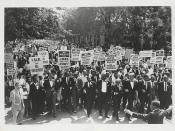T. S. Eliot, perhaps one of the most controversial poets of modern times, wrote what many critics consider the most controversial poem of all, The Waste Land. The Waste Land was written using a fragmented style. This is a style that is evident in all of Eliot's writings. There are several reasons for his using this approach, from a feeling of being isolated, to a problem articulating thoughts (Bergonzi 18, Cuddy 13, Mack 1745, Martin 102).
What influenced Eliot the most in writing poetry was a book he read written by the English critic, Arthur Symon, titled The Symbolist Movement in Literature. This book is about French symbolist writers of the 19th century. From this book, the author who had the greatest influence on Eliot is by far Jules Laforgue. Laforgue's influence is evident in many of Eliot's poems, sometimes to the point of plagiarism. Like Laforgue, Eliot uses dialogue between men and women that doesn't seem to communicate a thing.
Other author's had an influence on Eliot as well, like Henry James and Joseph Conrad. All of these poet's had the common themes of estrangement from people and the world, isolationism, and the feeling that they were failing to articulate their thoughts (Bergonzi 7, 50, Cuddy 30, Mack 1743, Martin 41, Unger 8) .
Henry James influence on Eliot's poetry is evident in the Jamesian qualities he uses. For example, the opening verse of The Waste Land ends with the Jamesian note, 'I
Cook 2
read, much of the night, and go south in the winter' (Mack, 1751). Although Lafourge, Conrad, and James were used as sources for Eliot when he composed poetry, there is still a distinct Eliotic quality whenever his work is read (Bergonzi 7, 50, Cuddy 55, Mack 1743, Martin 41, 97, Unger 10).


